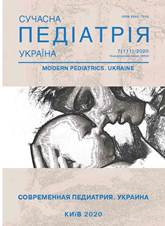Joubert's syndrome as a cause of cholestasis in children
Keywords:
Joubert syndrome, cholestasis, childrenAbstract
Literature review and a case report of Joubert syndrome in a preschool child are presented. This syndrome is accompanied by chronic intrahepatic cholestasis, characteristic facial dysmorphia, congenital malformations of the urinary system, eyes pathology, confirmed by a molecular genetic test of TMEM67 gene mutations. Diagnostic aspects of this pathology have been reviewed.
The clinical case description. Boy K was admitted to the pediatric hepatology department with respiratory and renal failure, decompensated acidosis. On admission, complaints included shortness of breath, severe itching, pale and dry skin, poor appetite and delayed physical development. On examination, dysembryogenic stigmas: large head circumference, elongated face, protruding forehead, high rounded eyebrows, deeply set eyes, hypertelorism, antimongoloid incision of the eyes, low auricles. The skin was pale, dry with the scratch marks on the arms and legs flexor surfaces. Ankles, wrists skin lichenification, bruising and hyperpigmentation was observed. Moderate palmar erythema, spider veins on the abdomen, watch-glass nails were present. The abdomen was enlarged due to hepatosplenomegaly. A clinical and paraclinical examination was conducted, the patient was consulted by related specialists. Based on the obtained data and molecular genetic examination, the diagnosis was made.
Conclusion. Joubert's syndrome may have a clinical presentation similar to that in cholestatic liver disease with typical clinical and laboratory symptoms. The molecular genetic testing is an important workup component in children with liver pathology combined with damage to other organs and systems. Successful treatment is possible providing a multidisciplinary approach used.
The study was conducted by the principles of the Declaration of Helsinki. The research protocol was approved by the Local Ethics Committee of the abovementioned institution. Informed consent of the child's parents was obtained for the research.
References
Aksenova ME. (2015). Nefronoftiz i nefronoftiz assotsiirovannyie sindromyi. Pediatriya. 94 (3): 82–87.
Bachmann-Gagescu R, Dempsey JC, Phelps IG, O'Roak BJ et al. (2015). Joubert syndrome: A model foruntangling recessive disorders with extreme genetic heterogeneity. J Med Genet. 52: 514-522. https://doi.org/10.1136/jmedgenet-2015-103087; PMid:26092869 PMCid:PMC5082428
Desmet VJ. (1992). Congenital diseases of intrahepatic bile ducts: variations on the theme «ductal plate malformation». Hepatology. 16: 1069-1083. https://doi.org/10.1002/hep.1840160434; PMid:1398487
Doherty D, Parisi MA, Finn LS, Gunay-Aygun M et al. (2010). Mutations in 3 genes (MKS3, CC2D2A and RPGRIP1L) cause COACH syndrome (Joubert syndrome with congenital hepatic fibrosis). J Med Genet. 47 (1): 8-21. https://doi.org/10.1136/jmg.2009.067249; PMid:19574260 PMCid:PMC3501959
Edvardson S, Shaag A, Zenvirt S, Erlich Y et al. (2010). Joubert syndrome 2 (JBTS2) in Ashkenazi Jews is associated with a TMEM216 mutation. Am J Hum Genet. 86: 93-97. https://doi.org/10.1016/j.ajhg.2009.12.007; PMid:20036350 PMCid:PMC2801745
European Association for the Study of the Liver. (2009). EASL Clinical Practice Guidelines: Management of cholestatic liver diseases. Journal of Hepatology. 51: 237-267. https://doi.org/10.1016/j.jhep.2009.04.009; PMid:19501929
Gunay-Aygun M, Font-Montgomery E, Lukose L, Tuchman Gerstein M et al. (2013, January). Characteristics of congenital hepatic fibrosis in a large cohort of patients with autosomal recessive polycystic kidney disease. Gastroenterology. 144 (1): 112-121. https://doi.org/10.1053/j.gastro.2012.09.056; PMid:23041322 PMCid:PMC4162098
Gunay-Aygun M. (2009). Liver and Kidney Disease in Cilopathies. Am J Med Genet C Semin Med Genet. 151C (4): 296-306. https://doi.org/10.1002/ajmg.c.30225; PMid:19876928 PMCid:PMC2919058
Guzeev GG, Kanivets IV, Korostelev SA, Semenova NA. (2013). Sindrom Zhuber. V pomosch praktikuyuschemu vrachu (lektsii, obzoryi). Detskaya bolnitsa: 2.
Heathcote EJ. (2007). Diagnosis and management of cholestatic liver disease. Clin Gastroenterol Hepatol. 5: 776-782. https://doi.org/10.1016/j.cgh.2007.05.008; PMid:17628332
Hildebrandt F, Benzing T, Katsanis N. (2011, April 21). Ciliopathies. N Engl J Med. 364 (16): 1533-1543. https://doi.org/10.1056/NEJMra1010172; PMid:21506742 PMCid:PMC3640822
Joubert M, Eisenring JJ, Robb JP, Andermann F. (1969). Familial agenesis of the cerebellar vermis. A syndrome of episodic hyperpnea, abnormal eye movements, ataxia, and retardation. Neurology. 19 (9): 813-825. https://doi.org/10.1212/WNL.19.9.813; PMid:5816874
Kremer AE, Beuers U, Oude-Elferink RP, Pusl T. (2008). Pathogenesis and treatment of pruritus in cholestasis. Drugs. 68: 2163-2182. https://doi.org/10.2165/00003495-200868150-00006; PMid:18840005
Novarino G, Akizu N, Gleeson JG. (2011, September 30). Modeling Human Disease in Humans: The Ciliopathies. 147 (1): 70-79. https://doi.org/10.1016/j.cell.2011.09.014; PMid:21962508 PMCid:PMC3202432
Parisi MA. (2009). Clinical and molecular features of Joubert syndrome and related disorders. Am J Med Genet C Semin Med Genet. 151C (4): 326-340. https://doi.org/10.1002/ajmg.c.30229; PMid:19876931 PMCid:PMC2797758
Parisi MA. (2019). The molecular genetics of Joubert syndrome and related ciliopathies: The challenges of genetic and phenotypic heterogeneity. Translational Science of Rare Diseases. IOS Press Content Library. 4: 25-49. https://doi.org/10.3233/TRD-190041; PMid:31763177 PMCid:PMC6864416
Rock N, McLin V. (2014, September). Liver involvement in children with ciliopathies. Clin Res Hepatol Gastroenterol. 38 (4): 407-414. https://doi.org/10.1016/j.clinre.2014.04.001; PMid:24953524
Srour M, Hamdan FF, McKnight D, Davis E et al. (2015). Joubert syndrome in french canadians and identi-cation of mutations in CEP104. Am J Hum Genet. 9: 744-753. https://doi.org/10.1016/j.ajhg.2015.09.009; PMid:26477546 PMCid:PMC4667103
Srour M, Schwartzentruber J, Hamdan FF, Ospina LH et al. (2012). Mutations in C5ORF42 cause Joube syndrome in the French Canadian population. Am J Hum Genet. 90: 693-700. https://doi.org/10.1016/j.ajhg.2012.02.011; PMid:22425360 PMCid:PMC3322222
Van de Weghe JC, Rusterholz TDS, Latour B, Grout ME et al. (2017, July 6). Mutations in ARMC9, which Encodes a Basal Body Protein, Cause Joubert Syndrome in Humans and Ciliopathy Phenotypes in Zebra-sh. The American Journal of Human Genetics. 101: 23-36. https://doi.org/10.1016/j.ajhg.2017.05.010; PMid:28625504 PMCid:PMC5501774
Downloads
Published
Issue
Section
License
The policy of the Journal “MODERN PEDIATRICS. UKRAINE” is compatible with the vast majority of funders' of open access and self-archiving policies. The journal provides immediate open access route being convinced that everyone – not only scientists - can benefit from research results, and publishes articles exclusively under open access distribution, with a Creative Commons Attribution-Noncommercial 4.0 international license (СС BY-NC).
Authors transfer the copyright to the Journal “MODERN PEDIATRICS. UKRAINE” when the manuscript is accepted for publication. Authors declare that this manuscript has not been published nor is under simultaneous consideration for publication elsewhere. After publication, the articles become freely available on-line to the public.
Readers have the right to use, distribute, and reproduce articles in any medium, provided the articles and the journal are properly cited.
The use of published materials for commercial purposes is strongly prohibited.

